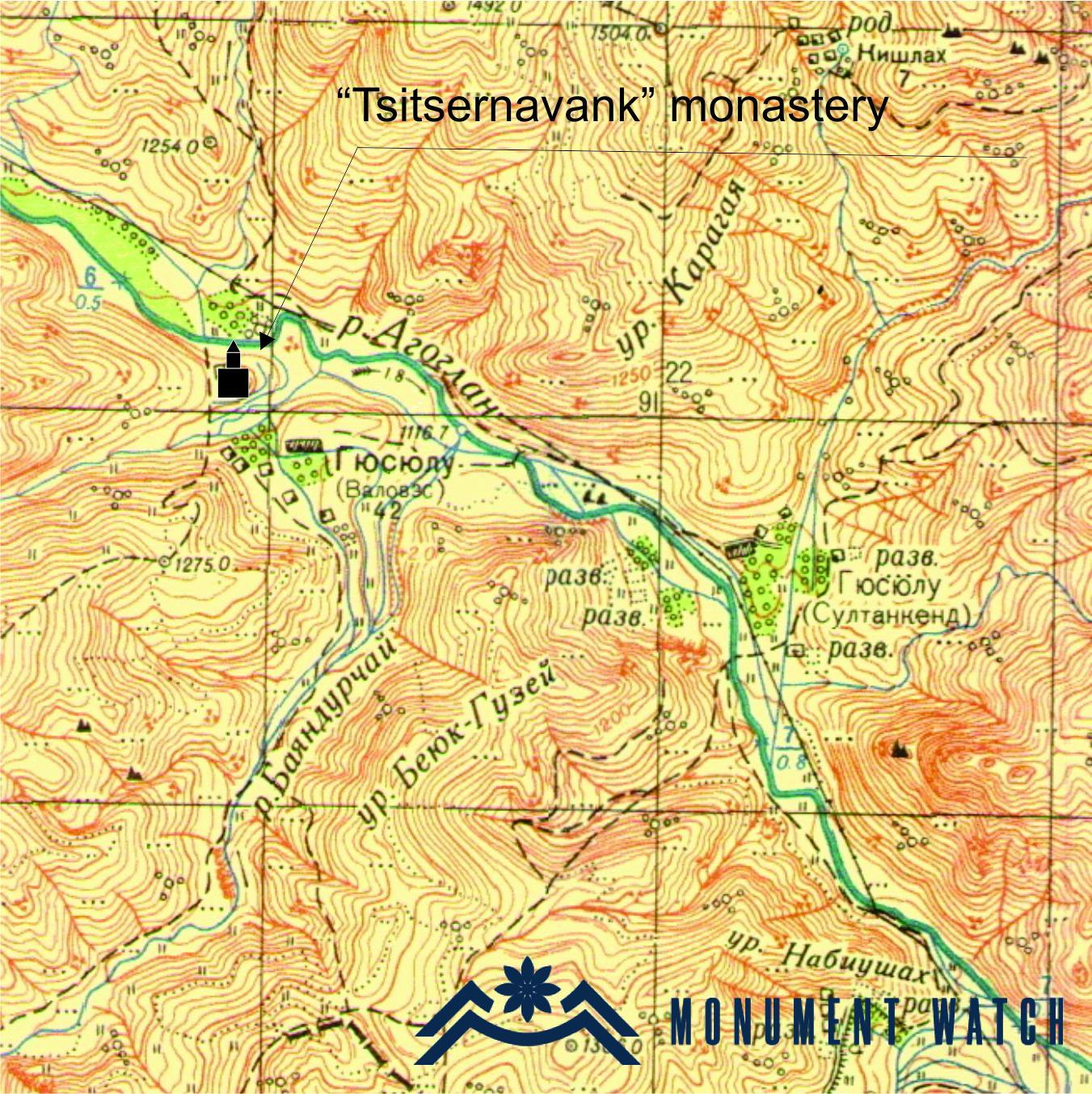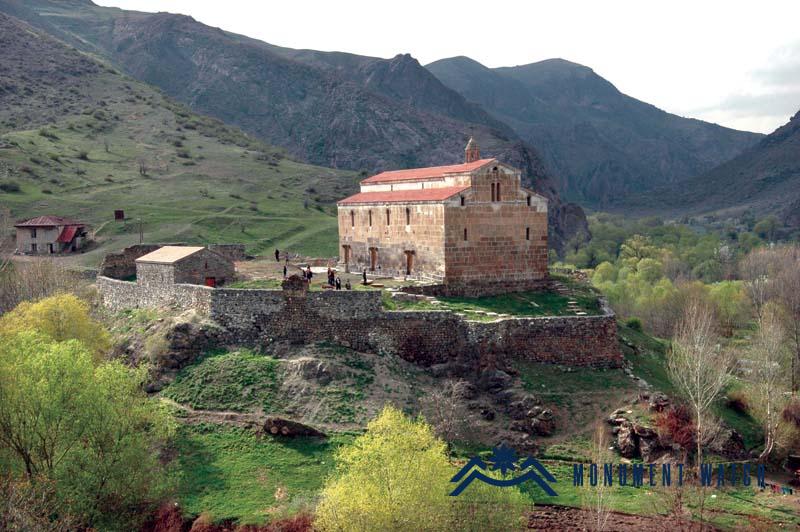Tsitsernavank
Location
Tsitsernavank is located on the northwestern edge of the namesake village in Kashatagh region of the Artsakh Republic (presently the Lachin region of Azerbaijan), in the historical Aghahejk canton of Syunik (Figs. 1, 2).


Fig. 1 The general view of Tsitsernavank, photo by S. Karapetyan.

Fig. 2 Tsitsernavank from the south-west, photo by H․ Abrahamyan.
Historical overview
In the sources Tsitsernavank is first mentioned by the 13th century historian Stepanos Orbelyan in three different parts of his book: “Stepanos – monk of ‘Tsitsarnay’” (mid-9th century), “‘Tsitsarnoy’ Monastery” (11-12th centuries), “Saint ‘Tsitsernaku’ Monastery” (13th century, Orbelian, 1910, 208, 249, 365), without details. It may be supposed that Stepanos living in the 9th century was the abbot of the monastery. The list of the tax-paying villages of Tatev Monastery, which presents the last chapter of the historian’s book, mentions the village of “Tsitsarnovank”, which apparently took its name from the monastery (Orbelian, 1910, 375). The next mention belongs to the 13th century historian Vardan Areveltsi – “Tsitsarnay Monastery” (Vardan 1960, 12). There is no information about the monastery or its separate structures in the abovementioned references.
The importance of Tsitsernavank in the following centuries is evidenced by the dithyramb of Archimandrite Tovma Vanandetsi (17th century), a number of other references and inscriptions. Ghevond Alishan referred to the monastery in his “Sisak” work, where he clarified the location of the monastery and presented the myths related to it (Alishan, 1893, 268). Yervand Lalayan in his work entitled “Zangezur” describes in detail the church and mentions the tradition according to which the little finger (in Arm: tsitsernae) of the Apostle Peter is enshrined in front of the northern vestry of the building (Lalayan 1898, 48) (Fig. 3).

Fig. 3 The first photo of Tsitsernavank, the photo from “Zangezur” book by Ye. Lalayan (negative picture: HMA).
Architectural-compositional examination
There is no written information about the time of construction of Tsitsernavank church. It is likely that it was built in several stages and received its present appearance in the 6th century (Figs. 4, 5).

Fig. 4 The plan of the church from the book “Armenian cultural monuments in the region of Karabakh” by S. Karapetyan, page 147.

Fig. 5 Tsitsernavank before the restoration, photo by S. Karapetyan.
The structure with its plan and volumetric-spatial compositions corresponds to the type of early medieval three-nave basilica churches in Armenia. The external dimensions of the church are: 25.6 meters long and 12.5 meters wide (Karapetyan, 2001, 143). Tsitsernavank has a rectangular plan, four pairs of pillars, and an externally emphasized medium-sized nave. Three of the four entrances are on the southern side and one on the northern side. The absence of the western entrance, as the excavations revealed, was conditioned with the presence of a large rock there, which was included in the volume of the western wall. Tsitsernavank bears on itself the effect of several construction stages. Two types of building materials are observed here: the lower rows of the outer walls are made of basalt, and the upper part is made of felsite. The pillars are decorated with chequered and double rows of dentils, wavy and woven sculptures, rosettes and other motifs. One of the peculiarities of the building is the balcony on the eastern altar, which is separated from the hall by a tripartite arch divided by two columns. The general territory of the monastery is walled, there are remains of several buildings, from which the refectory has been restored. A number of early Christian cross compositions and sculptures are preserved on the walls of the church (Figs. 6, 7, 8). There are a number of khachkars and tombstones of different periods in the area.

Fig. 6 Tsitsernavank from inside, photo by H. Petrosyan.

Fig. 7 From the early medieval cross images of Tsitsernavank, photo by H. Petrosyan.

Fig. 8 From the early medieval cross images of Tsitsernavank, photo by H. Petrosyan.
There are also a number of inscriptions, 8 of which are presented in the 5th issue of the “Divan of Armenian epigraphy” (CAI 1982, 192). M․ Hasratyan completed and presented 16, and S. Karapetyan 26 inscriptions. Two of the inscriptions (1613, 1779) are related to the construction activities. Traces of frescoes and red paint have been preserved on the walls of the building.
The condition before, during and after the war
Tsitsernavank was restored within the NKR in 2001. In addition to the church, the wall and the refectory were reinforced, the latter was turned into an exhibition hall-museum. New khachkars have been erected in the area.
Bibliographic examination
A number of legends about the monastery have been preserved in the bibliographic materials. Alishan presents a narrative according to which the crow warns the builders about the food poisoned by the snake, but at first they kill the bird without realizing it, then they bury it, calling the place “Crow’s grave”. Lalayan calls this place west of the church “Agravakhach” (Crow’s Cross). The church was a famous place of pilgrimage especially on the feasts of the Ascension and the Holy Cross. The monastery has also been a place of pilgrimage for the Muslims, who called it “Agh oghlan” (white child), meaning that it was built of white felsite (Lalayan 1898, 49).
In the Soviet and post-Soviet periods Tsitsernavank underwent professional study by M. Hasratyan and A. Sahinyan with the participation of Italian architects P. Cuneo and F. Gandonfo. In 1997 the structure was studied and measured by S. Karapetyan, and in 1997-2001 Tsitsernavank was subjected to archaeological research (H. Simonyan, H. Sanamyan), then restored.
Bibliography
1․ Alishan 1893 – Alishan Gh․, Sisakan, Venice.
2․ CAI – Corpus of Armenian Inscriptions, Release 5, Yerevan.
3․ Lalayan 1898 – Lalayan Ye., Zangezur, Ethnographic magazine, book 4, issue 2.
4․ Karapetyan 2001 – Karapetyan S., Armenian cultural monuments in the region of Karabakh, Yerevan.
5․ Hakobyan 2009 – Hakobyan A., The name of Tsitsernavank, the grave of the martyr and the construction stages – Hakobyan A., Historical-geographical and epigraphic researches (Artsakh, Utik). Mkhitaryan Publishing House, Vienna-Yerevan.
6. Harutyunyan 1992 – Harutyunyan V., History of Armenian Architecture, Yerevan.
7․ Hasratyan 1980 – Hasratyan M., Tsitsernavank, Historical-Philological Journal, Issue 2.
8․ Simonyan 2005 – Simonyan H., Reconsecrated Tsitsernavank, Monument, Issue 3, Yerevan.
9. Orbelian 1910 – S. Orbelian, History of the Province of Syunik, Tiflis.
Tsitsernavank
Artsakh